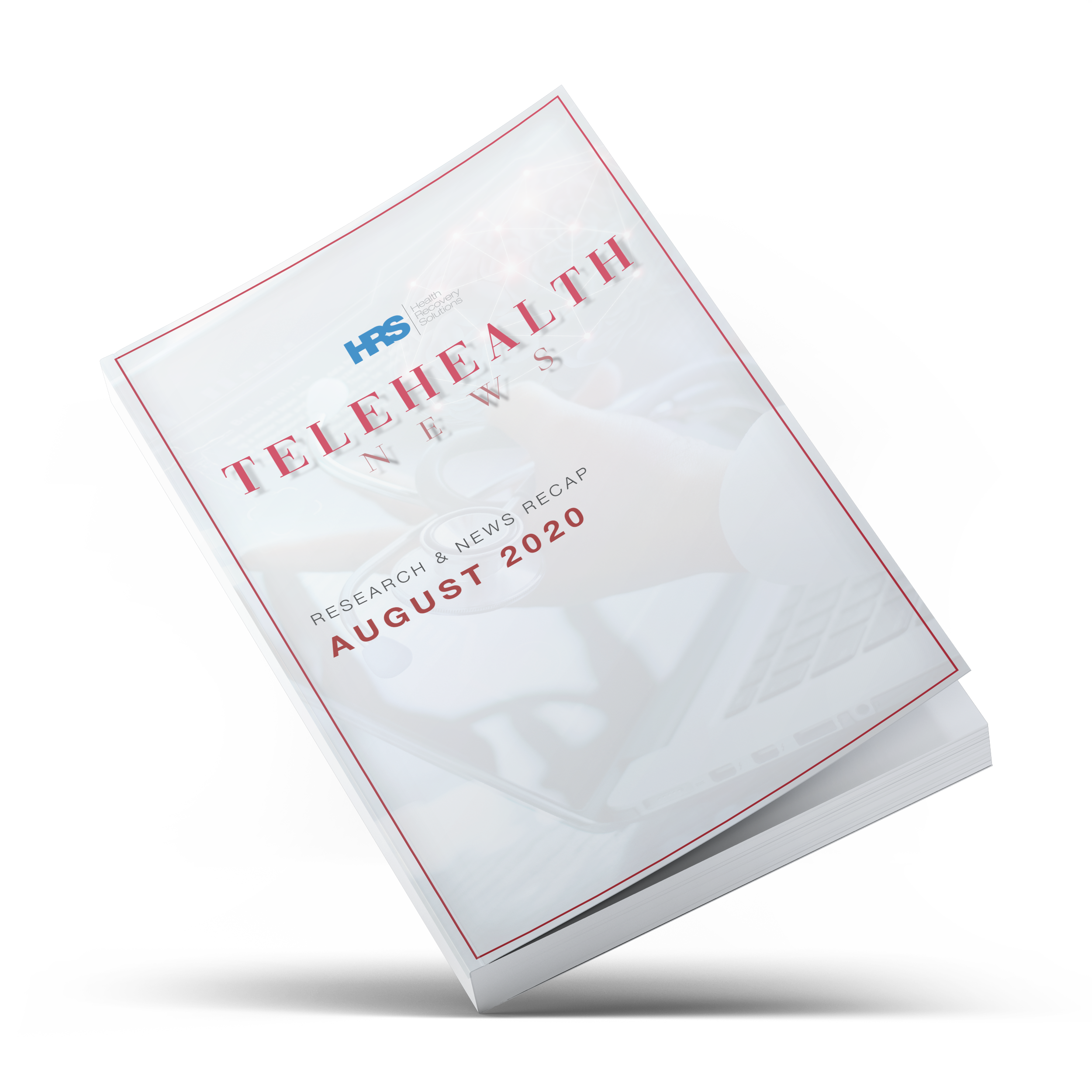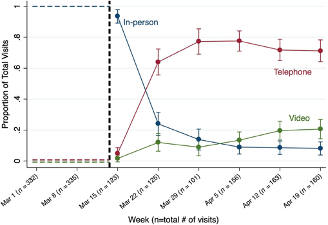
August 2020
Telehealth News:
Research & News Recap
Interest in remote patient monitoring (RPM) and its positive impact continues to grow as providers see the benefits of adding telehealth to their workflow. This has led to increased and extensive research on telehealth as well as changes to government policies. Explore recent research on the efficacy of telehealth and understand new rulings from the Center of Medicare and Medicaid Services (CMS) in HRS’ August 2020 Research & News Recap.
Part I. Research Findings - Remote Patient Monitoring and Telehealth
In this section two recently published studies on various RPM and telehealth topics are analyzed. An additional study outlines best practices established by a Health System in the Midwest as their geriatric department adapted to virtual visits at the onset of the COVID-19 pandemic. Real quantitative and qualitative data from telehealth patients was collected, studied, and conclusions were drawn in the studies included below. The results point to the positive impacts of RPM in healthcare and the growth potential of telehealth.
Article 1
Uptake of Virtual Visits in A Geriatric Primary Care Clinic During the COVID-19 Pandemic
What was studied?
As states across the US experience a resurgence of COVID-19 cases, providers are continuing to shift in-person visits to virtual services. Published by the American Geriatric Society, this study from the University of Michigan Medical center outlines how their multi-site geriatric clinic, providing over 300 in-person visits per week prior to COVID-19, shifted to video and telephonic visits at the onset of the pandemic. Over a five-week period, the geriatric program transitioned from delivery 0% of visits virtually to 91% of visits through phone and video platforms.

Best practices for adaptation
- Patient and caregiver Involvement: Prior to virtual and telephonic visits, patient and/or their caregivers were asked to measure blood pressure (BP), pulse, body weight, temperature, and glucose (if necessary). Due to the importance of accurate BP readings, the health system adapted to a provide “drive-through” BP visits
- Pre-visit medication review: Prior to virtual and telephonic visits, pharmacy technologists or medical assistant performed medication reconciliation with patients and/or their caregivers
- Pre-visit collection of patient information: Patients were asked to complete the following forms to provide a more complete picture of their health status: PHQ9, fall screening, social history, and physical and cognitive functional assessment
- Detailed patient medical history
Additional benefits
- During the first five weeks, over 1,135 travel miles were saved through virtual visits for an average of 24 miles saved per visit.
- Clinician skepticism over virtual care within the health system was dramatically reduced
- Virtual visit provided patients with an additional touch point during an especially isolating and lonely period of time, helping improve their mental and emotional health and well being
Access the full article, here.
Date Published: May 2020
Dewar, S., Lee, P., Suh, T., & Min, L. (2020, May 15). Uptake of Virtual Visits in A Geriatric Primary Care Clinic During the COVID‐19 Pandemic. Retrieved August 07, 2020, from https://onlinelibrary.wiley.com/doi/10.1111/jgs.16534
Article 2
Testing the Feasibility of Remote Patient Monitoring in Prenatal Care Using a Mobile App and Connected Devices: A Prospective Observational Trial
What was studied?
The George Washington University Hospital conducted an observational study over six months to evaluate the feasibility of monitoring prenatal risk factors via a mobile health solution. Participants (age 18-40) used Bluetooth devices to record their weight and blood pressure everyday throughout the first trimester of their pregnancy. The patients vital were recorded in their mobile application and daily readings, as well as weekly and monthly trends were available to the patient’s OBGYN at The George Washington University Hospital. In addition, educational material was available to participants via the mobile application including information regarding pregnancy progression, smoking, drug abuse and alcohol consumption risks, pregnancy warning signs, proper nutrition and appropriate weight gain.
Patients had access to the application through their mobile devices and were provided Bluetooth connected devices with which to record their daily vital signs. The application and devices were available to participants at no cost.
To examine the feasibility of remote patient monitoring for prenatal care, four key categories were evaluated: patient engagement, patient satisfaction, data accuracy, and efficacy of the alert system.
Patient Engagement- Weight collected an average of 1.5x per week, collected an average of 46 times per patient throughout the study (4.6x that of in-office only)
- Blood pressure collected an average of 1.1x per week, collected an average of 34 times per patient throughout the study (3.4x that of in-office only)
Data Accuracy
- No significant differences between weight and blood pressure recorded in office vs. through the mobile application indicating accurate data recorded
Risk Alert Efficacy
- During the study, no inappropriate alerts were received by the team. Two alerts were received through the study, both being relevant to the patient’s status and progress
Patient Satisfaction
- All study participants felt comfortable with the technology and monitoring concept and felt the resources (education) was beneficial. Most participants 83% felt the app helped them develop healthy behaviors and improve communication with their provider
Why do these findings matter?
Preeclampsia is the most common pregnancy complication, affecting 1 in 20 pregnancies. For preeclampsia (as well as gestational diabetes and premature birth) extreme weight gain and high blood pressure are significant risk factors. Early identification of these risk factors proves incredibly beneficial to pregnant women and their babies. The ability to consistently monitor blood pressure and weight gain throughout a pregnancy via a mobile application can enhance patients’ knowledge of their risk and better comply with their care as it has in similar studies with diabetes management, HIV medication adherence, and sickle cell anemia adherence.
Access the full article, here.Date Published: 2019
Marko KI, Krapf JM, Meltzer AC, et al. Testing the Feasibility of Remote Patient Monitoring in Prenatal Care Using a Mobile App and Connected Devices: A Prospective Observational Trial. JMIR Res Protoc. 2016;5(4):e200. Published 2016 Nov 18. doi:10.2196/resprot.6167
Article 3
Forging a New Frontier: Providing Palliative Care to People with Cancer in Rural and Remote Areas
What was studied?
Published in the Journal of Clinical Oncology, this literature review provides an analysis of the delivery of palliative oncology care in rural communities. The review focuses on the challenges to the current, standard delivery of palliative care and innovations in remote delivery. According to a WHO study, the US has one of the most well-developed palliative care networks of any developed country. However, a review of previous randomized clinical trials reveals significant barriers in the form of fragmented care services, blurred referral pathways, lack of palliative providers, an inadequate education. Following an analysis of the barriers to care in rural communities, this literature review presents innovations to care delivery from recent RCTs around the world.
Research findings
- Video and telephonic counseling (in addition to and in substitution for in-person counseling) for patients and their families
- Delivery of palliative care training through virtual platforms to rural primary care physicians to reduce provider shortages
- Providing patients and family caregivers with educational materials on palliative oncology care services and the end-of life process, targeting each stage of care
- Medication management, symptom monitoring and coordination with pharmacists via digital health tools
Why do these findings matter?
According to the Mayo Clinic, nearly 1.5 million Americans receive hospice care each year and over six million Americans would benefit from receiving palliative care who do not currently receive such care. In addition, recent studies suggest that early palliative care would be especially beneficial to cancer patients in rural communities where access to care is often limited. Providing support, education, and resources is essential during the palliative and end-of-life process, not only for patients but for their caregivers and family members. This study shows that digital health platforms such as telehealth and remote patient monitoring are a culturally appropriate and efficient
Access the full article, here.
Date Published: March 2020
Bakitas, DNSc, CRNP, M., Watts, PhD, K. A., Malone, MPH, E., Dionne-Odom, PhD, RN, J. N., McCammon, MD, S., Taylor, DNP, CRNP, R., . . . Elk, PhD, R. (2020, March 20). Article Tools. Retrieved August 07, 2020, from https://ascopubs.org/doi/abs/10.1200/JCO.18.02432
Part II. Reimbursement Updates
Throughout the COVID-19 pandemic, the Centers for Medicare and Medicaid Services (CMS) have made changes to their policies in order to make telehealth more accessible across the country. As we continue to move forward, new federal policies and state laws have been proposed to continue expanding reimbursement for telehealth and RPM services. Below, you can review recent reimbursement changes as well as insights from our reimbursement team.
Reimbursement Updates
CMS Proposes Expanding Telehealth Reimbursement After COVID-19
In early August, President Trump signed an executive ordering calling for the recent expansion of telehealth and RPM services, made at the onset of the COVID, to be made permanent. The expansion of services would focus specifically on rural communities where lack of access to transportation and increased hospital closures in recent years has led to a severe provider shortage in many parts of the country. According to CMS, an average of 13,000 telehealth visits per week were performed prior to the pandemic. However, in the final week of April alone, nearly 1.7 million virtual visits were performed between Medicare beneficiaries and their providers. The executive order services as another significant steps to expanding telehealth and RMP services and reimbursement.
Access the full article, here.
Date Published: August 4, 2020
Sokol, Emily. “CMS Proposes Expanding Telehealth Reimbursement After COVID-19.” MHealthIntelligence, MHealthIntelligence, 4 Aug. 2020, https://mhealthintelligence.com/news/cms-proposes-expanding-telehealth-reimbursement-after-covid-19.
-1.png?width=402&height=226&name=Research%20%26%20Blog%20Module%20(11)-1.png)
.png?width=402&height=226&name=Research%20%26%20Blog%20Module%20(4).png)
.png?width=402&height=226&name=Research%20%26%20Blog%20Module%20(1).png)
.png?width=402&height=226&name=Research%20%26%20Blog%20Module%20(2).png)

